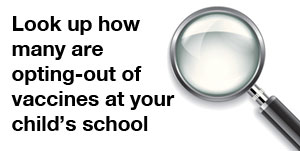
PBE rates vary by county and by individual school. In the Bay Area, Marin has the highest PBE rate by far -- 7.57 percent. (Marin was highest in the Bay Area last year too.) The PBE rate at private schools tends to be higher, overall, then that at public schools. In the 2013-2014 school year, only 85 percent of private school kindergarten students statewide were fully vaccinated when school started, compared to about 90 percent of public school students. Other students enter on "conditional" status, meaning the school is to follow up with these children to make sure they receive all their vaccines.
The California Department of Public Health collects vaccination rates and PBE rates at every kindergarten in the state with more than 10 students -- both public and private schools. Further below, we've made it easy for you to look up your own school.
Entering kindergarten children are required to be vaccinated against:
- Polio
- Diphtheria, Tetanus, and Pertussis (DTaP)
- Measles, Mumps, and Rubella (MMR)
- Hepatitis B
- Varicella (Chickenpox)
"We're definitely concerned" about the increasing PBE rates, said Dr. James Watt, chief of the state's division of communicable disease control. "We've been monitoring that. We've been increasing our analysis of the data to try to understand what's happening with that trend."
The biggest concern, he said, is not the overall statewide rate. But that growing rate signals that individual schools or areas may have very high PBE rates. "When those exemptions congregate in settings," Watt said, "that's the risk where disease transmission is greatest."
In 2014 alone, California has seen outbreaks of vaccine-preventable disease. "We've been grappling earlier this year with a lot of measles brought back in from other countries," Watt said. "We're in the middle of a whooping cough epidemic." The latest data from the state shows nearly 8,000 cases so far this year, and more than two-thirds of those hospitalized are infants younger than four months.
The state also experienced a whooping cough epidemic in 2010. Later research proved that vaccine refusal was a factor in the epidemic.
Under a new state law that went into effect on Jan. 1, parents who don't want to have their children vaccinated now must meet with a health care provider to discuss risks and benefits of vaccines. The provider must sign a form that the conversation has happened and the parent must provide a written statement.
After a similar law passed in Washington state in 2011, the PBE rate dropped 25 percent in 18 months. In California, the school year that is just starting is the first that makes this additional requirement of the PBE.
Watts said he hopes that the conversation with a health care provider "will help (parents) to come to decisions that will enable children to be protected against disease."
In comparison to Marin's 7.57 percent PBE rate, five other Bay Area counties have a significantly lower opt-out rates:
- San Francisco: 1.64 percent
- Santa Clara: 1.72 percent
- Alameda: 1.78 percent
- San Mateo: 2.26 percent
- Contra Costa: 2.32 percent
Find Any School in California
You can look up the personal belief exemption rate at your own school below. So you can see the trend, we include data from the 2007-2008 school year through the 2013-2014 school year, the most recent year for which data are available. This tool includes data from every kindergarten in the state, public or private, with 10 or more students.
The column to the far right — “PBE” — shows the percentage of children at a kindergarten with a personal belief exemption on file. The higher the number, the more children are not receiving vaccines. Enter your child's school in the search box:
See the search tool on its own page.
